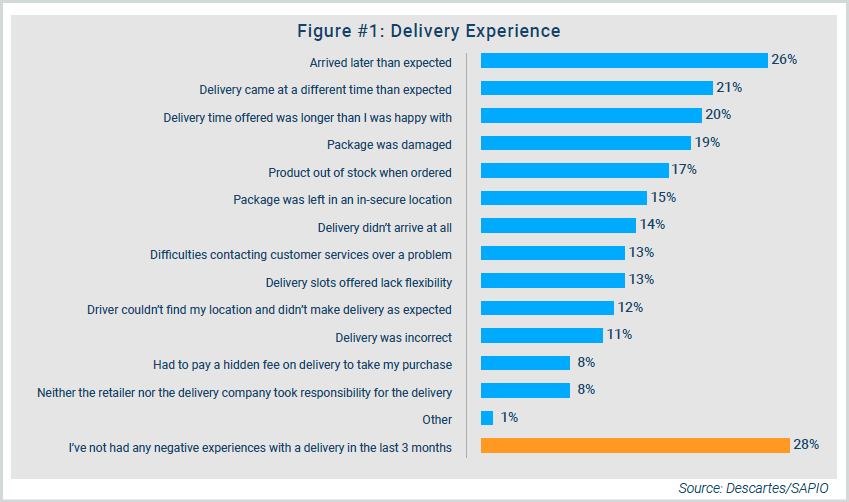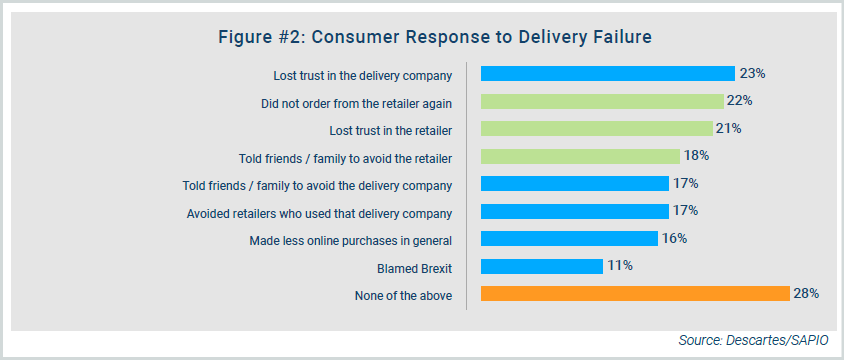The Damage Delivery Failures Can Cause and Getting Them Back on Track
Between the pandemic and rampant driver shortage, the quality of delivery service has significantly degraded over the last 18 months. While most retailers are challenged, complacency with the current situation is a recipe for disaster. Consumers are not so forgiving and can damage brand reputation or worse: consumers buying elsewhere and telling others to do the same.
Retailers and their delivery agents need to adopt strategies and technology to shore up their delivery performance to keep their consumers coming back for more or take market share from those that don’t.
The Current Situation
Descartes recently commissioned a pan-European home delivery consumer sentiment study. The research revealed that 72% of the over 5,000 respondents had some form of delivery failure in the 3 months prior to the survey. There were many reasons for failure, but the top three were all delivery time related (See Figure #1) and not just execution related.

Understandably, consumers are not taking this performance well and are either less committed or walking away from that retailer or their delivery agent. The top consumer responses (see Figure #2) drives this point home. For any retailer or delivery organization the numbers should be a wake-up call in terms of the number of consumers taking action on poor delivery performance.

Getting Delivery Performance Back on Track
The study clearly outlines that retailers and delivery agents need to shore-up their delivery performance to keep their customers from going elsewhere. Here are four focus areas to improve home delivery performance.
Planning
Consistent and reliable execution starts with realistic delivery plans. Today’s route optimization solutions are able to accurately model the road network, delivery time, order mix, customer location and other delivery requirements to create route plans that reflect the true time and driving path required. Optimized delivery planning also increases delivery capacity and given how hard it is to find new drivers, squeezing a few more deliveries on a route is an effective way to minimize the impact on delivery capacity.
Another important benefit of a more realistic delivery route is improved driver retention. When drivers’ route plans best represent the most efficient and reasonable way to get their deliveries executed, they are under less stress and less likely to leave the job.
Execution
The delivery route plan is the first step to improved performance, but management of route execution helps ensure that the delivery plan is successfully executed. Retailers need to track delivery performance to ensure drivers follow route plans and proactively address disruptions as they occur to minimize downstream impacts.
Using GPS-enabled mobile solutions and real-time performance monitoring helps to ensure drivers keep to the plan. When route disruptions are either happening or predicted to happen, drivers can be redirected to minimize the impact on subsequent deliveries.
Capturing actual delivery performance is also important to provide feedback that can be used adjust planning parameters to help create more accurate plans in the future.
EBOOK
Best Practices for Last Mile Delivery
Delivery strategies, tactics and technologies have evolved rapidly for B2C and B2B companies. Industry leaders have proven that they can compete on the strength of their delivery capabilities. Technology is an incredibly important enabler of world class delivery performance as its impact spans from demand generation to the post-delivery experience. Download the eBook to learn more.
Visibility
Given the increased demand for home delivery, driver capacity challenges and road network variability, it’s inevitable that there will be issues. Customers are more likely to have a less adverse opinion of a disruption if they become aware of the situation as it occurs and know the revised estimated-time-of-arrival (ETA).
To reduce customers’ anxiety, it’s important to communicate proactively from the moment of purchase through to post-delivery. Regular reminders help customers to prepare for their delivery in advance, while real-time ETA updates ensure that customers are on site at the right time. Map-based tracking gives customers a further insight into their driver’s arrival.
By providing customers with this level of operational transparency, businesses can increase the perceived value of their service and minimize the adverse effects of delays.
Delivery agents
Retailers using delivery agents need to understand the planning and execution strategies and supporting technologies of their delivery agents. Highly reliable delivery performance comes “by design.”
It is not enough for the agent to say that their people know the delivery geography. Unfortunately, too many delivery agents still rely heavily on manually-driven planning and do not proactively manage drivers in the field.
Both practices lead to reduced delivery reliability. Delivery tracking data is equally important to the retailer as it is to the consumer, so delivery agents not only need to have their drivers use real-time mobile solutions to capture delivery status, but they also need to be able to seamlessly provide that data to the retailer’s order tracking solutions or directly to the end customer.
Turning a challenge into a strength
The research underscores the potentially significant damage failed deliveries can bring to a retailer’s or delivery agent’s brand and even revenue. At a minimum, there is clearly value in improving the customer experience and keeping the customer happy to build loyalty.
However, since delivery failure is so widespread, it does provide an opportunity for retailers and delivery agents to use improved delivery performance as a competitive weapon to grow revenue and market share
ARTICLE
Fleet Resource Center
Expand Your Routing, Mobile & Telematics Knowledge
Recommended For You



